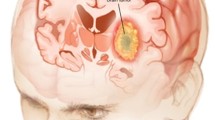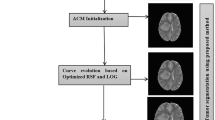Abstract
Digital transformation has brought radical changes in several domains. Particularly, image processing techniques have been generally used in medical, security, and monitoring applications. Image segmentation is a specific task where an image is partitioned in meaningful segments, containing similar features and properties. Its aim is to simplify the original image for easy analysis since relevant information is highlighted. These techniques are commonly used to support medical experts in detecting areas of interest in medical images. Level set method is a methodology for image segmentation, which works with minimizing energy for segmentation of the image by active contours. The areas inside each contour belong to distinct segments. In active contour-based models, the level of each contour changes according to the intensity values (region-based active contours) or the gradient variations (edge-based active contours). Here, a new edge–region level set algorithm for image segmentation is proposed which controls the curve movement based on both intensity and gradient values. Moreover, the original active contour model has been modified by considering both the mean and the variance values of the pixels’ neighborhood, instead of the mean value only. Indeed, in homogeneous regions with the same mean value could be assigned to the same segment while belonging to different ones. Since the initial curve definition is crucial for level set methods, a new methodology for initial curve detection based on Canny edge detector has been proposed. Experiments have been conducted on brain tumor magnetic resonance imaging (MRI). Images from Whole Brain Atlas (Harvard University Medical School) datasets, part Neoplastic Disease (brain tumor) have been used. Results have shown that the suggested approach is able to accurately detect tumor regions in the images and to overcome the original active contour models such as CV, LBF, and LIF. Using semi-average filter in pre-processing stage can strengthen edges and it led to detecting more strong edges in Canny edge detector.












Similar content being viewed by others
Data Availability
The datasets analyzed during the current study are available in the Whole Brain Atlas dataset, Neoplastic Disease (brain tumor) part, www.med.harvard.edu/aanlib.
References
Weller M, Wick W, Aldape K et al (2015) Glioma. Nat Rev Dis Primers 1:15017
Vlaardingerbroek MT, Boer JA (2013) Magnetic resonance imaging: theory and practice. Springer Science & Business Media
Hameurlaine M, Moussaoui A (2019) Survey of brain tumor segmentation techniques on magnetic resonance imaging. Nano Biomed Eng 11(2):178–191
Bajaj AS, Chouhan U (2020) A review of various machine learning techniques for brain tumor detection from mri images. Curr Med Imag 16(8):937–945
Magadza T, Viriri S (2021) Deep learning for brain tumor segmentation: a survey of state-of-the-art. J Imag 7(2):19
Lella E, Vessio G (2020) Ensembling complex network ‘perspectives’ for mild cognitive impairment detection with artificial neural networks. Pattern Recogn Lett 136:168–174
Mahdi M, Nasser A (2021) A three-stage shearlet-based algorithm for vessel segmentation in medical imaging. Pattern Anal Appl. https://doi.org/10.1007/S10044-020-00915-3
Siadat M, Aghazadeh N, Akbarifard F, Brismar H (2019) Joint image deconvolution and separation using mixed dictionaries. IEEE Trans Image Process 28(8):3936–3945
Cigaroudy LS, Aghazadeh N (2017) A new multiphase segmentation method using eigenvectors based on k real number. Circuits Syst Signal Process 36(4):1445–1454. https://doi.org/10.1007/S00034-016-0359-7
Cigaroudy LS, Aghazadeh N (2017) A multiphase segmentation method based on binary segmentation method for Gaussian noisy image. Signal Image Video Process 11(5):825–831. https://doi.org/10.1007/S11760-016-1028-9
Aghazadeh N, Akbarifard F, Ladan SC (2016) A restoration-segmentation algorithm based on flexible Arnoldi-Tikhonov method and curvelet denoising. Signal, Image Video Process 10(5):935–942. https://doi.org/10.1007/S11760-015-0843-8
Cigaroudy LS, Aghazadeh N (2022) A Binary-Segmentation algorithm based on shearlet transform and eigenvectors, 2nd International Conference on Pattern Recognition and Image Analysis (IPRIA). https://doi.org/10.1109/PRIA.2015.7161618.
Narkhede HP (2013) Review of image segmentation techniques. Int J Sci Modern Eng 1(8):54–61
Caponetti L, Castellano G, Corsini V (2017) Mr brain image segmentation: a framework to compare different clustering techniques. Information 8(4):38
Liu T, Xu H, Jin W, Liu Z, Zhao Y, Tian W (2014) Medical image segmentation based on a hybrid region-based active contour model. Comput Math Methods Med 2014:1–10. https://doi.org/10.1155/2014/890725
An J-H, Chen Y (2007) Region based image segmentation using a modified Mumford-Shah algorithm. In: International conference on scale space and variational methods in computer vision. Springer, pp 733–742
Muller S, Ochs P, Weickert J, Graf N (2016) Robust interactive multi-label segmentation with an advanced edge detector. In: German conference on pattern recognition. Springer, pp 117–128
Xiangyang X, Shengzhou X, Jin L, Song E (2011) Characteristic analysis of Otsu threshold and its applications. Pattern Recognit Lett 32(7):956–961
Mehndiratta A, Giesed F (2011) Brain tumor imaging. In book: Diagnostic Techniques and Surgical Management of Brain Tumors. https://doi.org/10.5772/23507
Khairandish MO, Sharma M, Jain V, Chatterjee JM, Jhanjhi NZ (2022) A Hybrid CNN-SVM threshold segmentation approach for tumor detection and classification of MRI brain images. IRBM 43(4):290–299
Sivakumar V, Janakiraman N (2020) A novel method for segmenting brain tumor using modified watershed algorithm in MRI image with FPGA. Biosystems 198:104226. https://doi.org/10.1016/j.biosystems.2020.104226
Daimary D, Mayur BB, Khwairakpam A, Debdatta K (2020) Brain tumor segmentation from MRI images using hybrid convolutional neural networks. Proc Computer Sci 167:2419–2428
Jaspin Jeba Sheela C, Suganthi G (2022) Automatic brain tumor segmentation from MRI using greedy snake model and fuzzy C-means optimization. J King Saud Univ- Computer Inf Sci 34(3):557–566
Amin J, Sharif M, Gul N, Yasmin M, Shad SA (2020) Brain tumor classification based on DWT fusion of MRI sequences using convolutional neural network. Pattern Recognit Lett 129:115–122
Mumford DB, Shah J (1989) Optimal approximations by piecewise smooth functions and associated variational problems. Commun Pure Appl Math 25:46
Bickey KS, Vansh K, Rohan R, Sakil A, Anshul S (2020) Evaluation and comparative study of edge detection techniques. IOSR J Computer Eng 22(5):06–15
Sert E, Avci D (2019) A new edge detection approach via neutrosophy based on maximum norm entropy. Expert Syst Appl 115:499–511
Sangeetha D, Deepa P (2019) FPGA implementation of cost-effective robust Canny edge detection algorithm. J Real-Time Image Process 16(4):957–970. https://doi.org/10.1007/s11554-016-0582-2
Kim W, Kim C (2012) Active contours driven by the salient edge energy model. IEEE Trans Image Process 22:1667–1673
Lecellier F et al (2010) k Region-based active contours with exponential family observations. J Math Imag Vis 36:28
Cohen R (2011) The chan-vese algorithm. http://arxiv.org/abs/1107.2782
Osher S, Sethian JA (1988) Fronts propagating with curvature-dependent speed: Algorithm based on Hamilton-Jacobi formulations. J Comput Phys 79(1):12–49
Ali H, Badshah N, Chen K, Khan G (2016) A variational model with hybrid images data fitting energies for segmentation of images with intensity inhomogeneity. Pattern Recognit 51:27–42
Wang X, Huang D, Xu H (2010) An efficient local Chan-Vese model for image segmentation. Pattern Recognit 43(3):603–618
Mabood L, Ali H, Badshah N, Ullah T (2015) Absolute median deviation based a robust image segmentation model. J Inf Commun Technol 9(1):13–22
Zhang K, Song H, Zhang L (2010) Active contours driven by local image fitting energy. Pattern Recognit 43(4):1199–1206
Jayadevappa D, Kumar S, Murty D (2011) Medical image segmentation algorithms using deformable models: a review. IETE Tech Rev 28(3):248–255
Li C, Wang X, Eberl S, Fulham M, Feng D (2013) Robust model for segmenting images with/without intensity inhomogeneities. IEEE Trans Image Process 22(8):3296–3309
Wang B, Gao X, Tao D, Li X (2014) A nonlinear adaptive level set for image segmentation. IEEE Trans Cybern 44(3):418–428
Wang H, Liu M (2013) Active contours driven by local gaussian distribution fitting energy based on local entropy. Int J Pattern Recognit Artif Intell 27(6):1073–1089
Chen F, Yu H, Hu R (2013) Shape sparse representation for joint object classification and segmentation. IEEE Trans Image Process 22(3):992–1004
Mylona E, Savelonas M, Maroulis D (2014) Automated adjustment of region-based active contour parameters using local image geometry. IEEE Trans Cybern 44(12):2757–2770
Yang X, Gao X, Li J, Han B (2014) A shape-initialized and intensity-adaptive level set method for auroral oval segmentation. Inf. Sci. 277(2):794–807
Hong-Kai ZT, Chan B, Merriman SO (1996) A variational level set approach to multiphase motion. J Comput Phys 127(1):179–195
Chan TF, Vese LA (2001) Active contours without edges. IEEE Trans Image Process 10(2):266–277
Li Bing N, Chui Chee K, Chang S, Ong Sim H (2011) Integrating spatial fuzzy clustering with level set methods for automated medical image segmentation. Computers Biol Med 41(1):1–10
Li C, Kao C-Y, Gore JC, Ding Z (2007) Implicit active contours driven by local binary Fitting energy, In 2007 IEEE Conference on Computer Vision and Pattern Recognition, pp 1–7
Li C, Kao C-Y, Gore JC, Ding Z (2008) Minimization of region scalable fitting energy for image segmentation. IEEE Trans Image Process 17(10):1940–1949
Canny J (1986) A computational approach to edge detection. IEEE Trans Pattern Anal Mach Intell 6:679–698
Hunderi AH, Karunakaran N (2013) Segmentation of medical image data using level set methods, master thesis, department of computer and information science, Norwegian University of Science and Technology
Author information
Authors and Affiliations
Corresponding author
Ethics declarations
Conflict of interest
The authors declare that they have no conflict of interest.
Additional information
Publisher's Note
Springer Nature remains neutral with regard to jurisdictional claims in published maps and institutional affiliations.
Rights and permissions
Springer Nature or its licensor (e.g. a society or other partner) holds exclusive rights to this article under a publishing agreement with the author(s) or other rightsholder(s); author self-archiving of the accepted manuscript version of this article is solely governed by the terms of such publishing agreement and applicable law.
About this article
Cite this article
Aghazadeh, N., Moradi, P., Castellano, G. et al. An automatic MRI brain image segmentation technique using edge–region-based level set. J Supercomput 79, 7337–7359 (2023). https://doi.org/10.1007/s11227-022-04948-9
Accepted:
Published:
Issue Date:
DOI: https://doi.org/10.1007/s11227-022-04948-9




